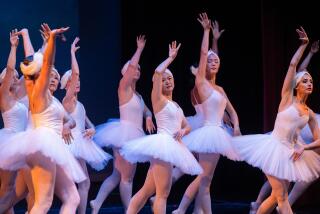O.C. Dancers Lead in Ballroom Circuit
- Share via
GARDEN GROVE — Sweat flies as David Hamilton and Olga Foraponova sweep across the worn oak floor, striving to dance as one though they clash in height, weight and, often, in opinion.
“I’ll say, ‘I want to hit this movement with a lot of intensity,’ ” Hamilton said. “Then she might say, ‘I want to hit it softly.”’
These tiffs can get physical, escalating to a butt-swat, but the result evokes a flawlessly synchronized couple circling a chandeliered ballroom on the Champs Elysees.
This practice dance, however, takes flight in a converted warehouse abutting a carpet store in Garden Grove. The “hard hat community,” as a councilman once described it, houses Kim’s Ballroom, a magnet for dancers who give Orange County international bragging rights in an intensely competitive field that is gaining visibility worldwide.
Over the last 20 years, a dozen or so dancers living or training here under five-time U.S. ballroom champs Brian and Kristi McDonald, among other coaches, have won titles on the professional national circuit. And although no American has ever claimed a world crown, local dancers routinely finish near the top.
Hamilton and Foraponova are favored to take a U.S. professional championship next month in Miami Beach, Fla.--his second--and they’ll try for their first world victory in November in Germany.
Another couple, Victor and Tiffany Fung of Laguna Hills, also will travel to Europe this fall, to vie for an amateur world title. The teen-age brother-and-sister team qualified by snatching first place last weekend in a Delaware contest sponsored by the U.S. Amateur Ballroom Dance Assn., whose membership has more than doubled to 16,000 since 1993.
Watching both couples’ progress will be a growing corps of local fans, from lesser competitors to dance hobbyists.
Janet Allen, a Riverside senior citizen who trains for pro-am contests at Kim’s, has the figure and spirit of someone half her age. “Dancing is an art form,” she said, taking a break from a lesson, “and learning to move to the music is very enjoyable.”
Also following the action will be non-dancers who may have recently stumbled upon the ballroom phenomenon on TV or at the movies.
“They come into the lobby and do a little dance” after seeing “Shall We Dance,” said Mike Peterson, manager of the Port Theatre in Corona del Mar. The Japanese film, along with Australia’s 1992 “Strictly Ballroom” and the forthcoming “Shut Up and Dance,” centers around the dance floor.
Producers of “Shut Up and Dance,” due out in February, hired several dancers who live or coach in Orange County, many of them already familiar to the millions who view “Championship Ballroom Dancing,” the annual TV spectacle that’s one of PBS’ biggest hits. Eight of 12 finalists featured on last year’s telecast had trained in Orange County under the McDonalds.
The renowned coaches immigrated to Oklahoma from Scotland after competing together internationally for 23 years. They moved in 1980 to Orange County, where many of their students were living. They soon founded the Embassy Ball, a dance contest that draws an elite group of competitors from around the world. At this year’s event, over Labor Day weekend in Costa Mesa, the winners will pocket as much as $1,000.
“They come there because they realize that the competition is one of the world’s foremost and that Brian and Kristi do things correctly,” said Robin Short, president of the England-based council that governs professional competitive ballroom dance worldwide. “They are [among] the foremost trainers in America.”
Despite its recent exposure on the screen, competitive ballroom dance remains a curiosity to most Americans. But it demands the same athleticism of gymnastics or figure skating, practitioners say.
The International Olympic Committee in 1995 granted dance sport, as it’s also called, provisional recognition, the first step toward full Olympic status. That’s unlikely to occur before 2008, because ballroom must stand in line behind such other would-be Olympic sports as karate. And its amateur and professional factions must settle an internal debate over which group gets to go for the gold.
Ballroom competition began in England in the 1920s, and Great Britain has turned out the largest number of world-title holders, Brian McDonald said. Scoring is subjective, with judges looking for precise leg and footwork, musical interpretation, choreographic creativity and a couple’s ability to move harmoniously and buoyantly.
Hamilton and Foraponova, who specialize in American Smooth dances (waltz, fox trot, tango and Viennese waltz), travel the San Diego Freeway from Los Angeles once a week to train with the McDonalds. Huntington Beach residents Igor and Irina Suvorov, who emigrated from Russia, also take instruction from the McDonalds at Kim’s, which was opened in 1986 by dancer and teacher Heung Kim.
Garden Grove is no St. Petersburg, which gave the world Peter Ilich Tchaikovsky and Anna Pavlova but . . . .
“It doesn’t matter,” Irina Suvorov said with a smile, “as long as it doesn’t get too hot.”
Aspiring dancers in the Los Angeles area also keep coaches busy. Just-retired champion Victor Veyrasset, who won the U.S. title 10 times, teaches at 2005 in Torrance. He studied with the McDonalds for 14 years. Before Veyrasset or his peers mastered reverse turns or twinkles, John Morton, a former Scottish champ, was the man to see. He has run the respected Westmor Dance Studios near downtown Los Angeles since the early ‘60s.
“L.A. has always been a good ballroom town,” Morton said. “In the late ‘30s, we had so many big ballrooms around, like the Old Colonial, and a place on Lick’s Pier in Venice where Lawrence Welk got his start.”
Hamilton, who practices and coaches at Westmor, was smitten from his first ballroom lesson as a teen in his native Nashville. He began training with the McDonalds 10 years ago and won his first U.S. title in 1995 with Teresa Shiry of Los Angeles. After she retired, he paired with Foraponova, a gymnast and ballroom dancer in her native Russia who moved here two years ago.
“Not to disregard any of my other partners,” Hamilton said, “but dancing with Olga is probably the highlight of my career because she’s just so . . . fabulous.”
The couple hope to wrest the national championship in American Smooth--one of four major dance categories--from New York’s Edward Simon and Michelle Officer, whom they’ll face next month.
“In the past year, we’ve competed against them nine times,” Hamilton said, “and we’re six to their three.”
Such determination is standard in a world where practice lasts eight to 10 hours a day, six days a week. In a recent session at Kim’s on the near-regulation 3,500-square-foot floor, the tall, dark Hamilton beckoned his partner, extending his left arm to shoulder height. With the quiet poise of a princess, Foraponova settled into his embrace.
The music soared and the couple followed, only to stop abruptly seconds later. “It’s taken us a year to get together,” Hamilton explained, slouching with hands on hips to discuss what worked and what didn’t. “The shapes and the movements of your bodies have to be in sync.”
To every practice, Hamilton totes a survival kit that includes fresh clothes, extra shoes, cans of water-packed tuna, Advil and apple juice boxes. A plastic pouch contains vitamins and herbal remedies for the damaged cartilage in his knee, which is usually swathed in a black brace.
He takes off three days a month, the only time spent apart from Foraponova, with whom he flies some 70,000 miles a year to contests, lessons and exhibitions. They share hotel rooms to cut costs.
“One would automatically assume we’re married, and we basically are,” Hamilton said. “We just don’t sleep together.”
Winning makes the regimen worthwhile, he added.
“That moment when you hear your number being called as the United States champion . . . it’s sort of an out-of-body experience. Everything is suspended. Then it just hits you.”
The celebrity that accompanies such achievement helps stoke the county’s thriving recreational ballroom scene.
The slick Feather magazine, published in Laguna Beach, has delivered ballroom news to a loyal 10,000 subscribers for a dozen years. And Kim’s and other respected ballroom dance schools in Newport Beach, Buena Park and Santa Ana host frequent dance parties.
With her pierced nose and ears, Dibi Fletcher of San Clemente doesn’t fit the flouncy-skirted image of a ballroom dancer. Her new hobby breaks with a family tradition: Husband, Herbie, and sons Christian and Nathan are famous surfing fanatics.
But Fletcher has even gotten her 70-year-old mother into a ballroom class four days a week, and into competition.
“It’s fun to learn to couple dance,” she said. “It’s about leading and following, about being responsive, about body awareness, about social graces. I’d like to have these young guys I know--surfers and skate- and snowboarders--participate.”
That’s probably a long shot, but an Olympic competition might help erase the common notion that ballroom is for out-of-shape seniors. And the dancers know they must shed their dated trappings--$3,000 gowns, feathery boas, frozen smiles, lacquered hairdos--to attract a mainstream following.
“How can we expect to have a sport with worldwide appeal when it would be impossible for some countries to clothe any reasonable number of competitors?” noted Peter Pover, vice president of the International DanceSport Federation.
Brian McDonald agreed: “We realize some of that’s got to change to take dance into the next millennium.”


